Centrism
Are Centrists Really Most Hostile to Democracy?
Centrists routinely accuse their political rivals of undermining democracy.

Last week, David Adler published an article in the New York Times, in which he summarized his research on the relationship between political ideology and hostility to democracy. The recent rise of various populist movements in the West has caused many to fret that democratic norms and institutions may be at risk. The conventional wisdom is that extremists on the far-Left or far-Right are most threatening to these norms and institutions. But the conventional wisdom, Adler argues, is wrong. In the working paper he presents in the New York Times, he contends that, despite what pundits would have us believe, it’s actually centrists who are the most hostile to democracy and most supportive of authoritarian alternatives.
As soon as the New York Times published his op-ed, Adler’s findings were promoted and circulated on social media by those on the Left and Right weary of being held responsible for democracy’s predicted demise. If—like me—you are not a centrist, then you may have found this gloating understandable. Centrists routinely accuse their political rivals of undermining democracy, and now here was evidence purportedly demonstrating that they are the ones most likely to support authoritarianism.
The supercilious air of pragmatic rationality that centrists award themselves can certainly be annoying. So can their habit of relying on an implied argument to moderation—the fallacious assumption that any position which “splits the difference” is, ipso facto, the most reasonable. Sometimes the correct position is somewhere between two extremes, but more often than not this isn’t the case. The reasonable position on slavery, for instance, is not located somewhere between a thoroughgoing defence and an absolutist commitment to abolition. That abolitionism was once considered extreme didn’t make it any less correct than it is today, now that abolitionism is the default position of every humane person.
So, I sympathize with those who uncritically embraced this new narrative and seized upon the opportunity to give centrists a dose of their own medicine. But, having read Adler’s paper and looked at the data, we should probably resist this temptation. Perhaps Adler is right and centrists really are distinctly hostile to democracy. But in my opinion this claim is not well supported by his research. Before I explain why I think so, however, I want to make clear what exactly is the claim that Adler is making. Indeed, I have found that people were often confused about this when they talk about his paper, including at times Adler himself.

One of the reasons Adler’s op-ed was met with such enthusiasm is that it spoke to a widespread perception that political and cultural elites only care about democracy when the people does what those elites want. The rest of the time, they are happy to ignore popular opinion. A few days ago, the European Budget Commissioner Günther Oettinger lent support to this view when he suggested that markets would soon teach Italians how to vote more wisely. He was commenting on the decision by Sergio Mattarella, the Italian President, to refuse to accept the government proposed by the alliance of populist movements that won the elections a few months ago.
Now, I happen to agree that the elites are often contemptuous of popular opinion when it is not to their liking. But it is important to distinguish that claim from the claim Adler is making and what his data purport to show. His paper examines the attitudes of centrists in general, not just, or even mainly, the attitudes of the elites. Adler’s specific claim is that people who place themselves in the center of the political spectrum are the most hostile to democracy and the most supportive of authoritarianism. This claim may be false even if, among the elites, centrists are particularly hostile to democracy.
Now, while I agree that the elites are typically disdainful of democracy (although I don’t think they have much sympathy for the kind of authoritarian alternatives Adler is discussing in his paper), I don’t think this is particularly true of centrist elites. Indeed, in Adler’s classification (about which, more in a moment), Oettinger would presumably be center-Right and not centrist. Yet it is people in the center—not on the center-Left or the center-Right—who Adler claims are the most hostile to democracy. So, with that in mind, let us turn to the substance of his argument.
In order to make his case, Adler has relied on the World Values Survey (WVS) and the European Values Survey (EVS), which are very large surveys asking people in several countries various questions about politics and values. Both surveys include a question asking people to position themselves on the Left-Right spectrum by picking a number between 1 and 10. Adler created five groups depending on their answers. Those who answered 1 or 2 were classified as “far-Left,” those who answered 3 or 4 as “center-Left,” those who answered 5 or 6 as “center,” those who answered 7 or 8 as “center-Right” and those who answered 9 or 10 as “far-Right.” He then looked at how people in those groups answered various questions about democracy.
His findings not only run against the conventional wisdom, but they are powerfully counter-intuitive. For instance, he discovered that in both the US and Europe, centrists were significantly less likely than other respondents to say that democracy was a “very good” political system or to agree “very strongly” that it was the best political system respectively:

These figures are taken from Adler’s paper and they show a clear slump in the middle where people who position themselves at the center of the Left-Right scale are located.
He also found that centrists were more likely than other people to support authoritarian alternatives to democracy. Both the WVS and the EVS asked respondents how they feel about a strong leader who doesn’t bother with parliament and elections (the possible answers were “very bad,” “bad” in the WVS or “fairly bad” in the EVS, “fairly good” and “very good”), which allowed Adler to construct the following graph:

This graph shows the proportion of people in each group answering “fairly good” or “very good.” Except for those Europeans who place themselves at the far-right of the political spectrum, we again find that, according to this measure, centrists are the group with the highest level of support for a strong leader.
Adler looked at a bunch of other questions and also performed a regression analysis that included age, income and education as covariates to make sure the effect wasn’t confounded. This appeared to confirm that centrists are more hostile to democracy and more supportive of authoritarian alternatives than other people, even when controlling for these socio-economic variables. In other words, it’s not that people who place themselves in the middle of the Left-Right political spectrum tend to be less educated, older or have some other characteristic that is associated with lower support for democracy. According to Adler, there is something rotten with the center itself.
There is more in Adler’s paper, which I encourage you to read, but you probably get the general idea by now. The data Adler marshals appear to be clear and unequivocal. So what’s the problem?
First, while Adler’s regressions show that centrism is more strongly associated with anti-democratic attitudes, the coefficient of determination or “R-squared” is tiny. When the variables for age, income and education are not included, it ranges from 0.006 to 0.02. In other words, political ideology, as defined by Adler, explains only between 0.6 percent and 2 percent of the variance in democratic attitudes in the data, which is really not much. If all you know about someone that he is a centrist—or that he belongs to any of the five groups defined by Adler, for that matter—you basically can’t predict anything about how much he supports democracy. (Well, you can predict that he probably supports democracy quite a lot, because most people in every group do, but you can’t predict with any certainty how much less he supports democracy than anyone else.) So, even if the phenomenon Adler claims to have identified were real, it’s not clear that it would be very significant. But it’s not also not clear that the phenomenon in question is real.
For instance, as noted, Adler found that a lower share of centrists in both Europe and the US agreed “very strongly” with the claim that democracy was the best political system (EVS) or answered that it was a “very good” political system (WVS). But if you look at the proportion of people who either agreed very strongly or simply agreed and at the proportion who either answered “very good” or just “good,” the effect no longer seems as clear:

Now, in Europe, centrists are somewhat more likely to agree/agree strongly with the statement than those on the far-Left and about as likely to do so as those on the far-Right. In the US, they are still less likely than most groups to agree/agree strongly that democracy is a good/very good political system, but now that proportion has diminished to about the same as the proportion of those on the far-Right. Perhaps more importantly, more than 89 percent of centrists in Europe and more than 77 percent of them in the US do, which is pretty high. Are we to understand that anyone who agrees that democracy is the best political system or that it’s a good political system, but doesn’t agree strongly or affirm that it’s very good, is hostile to democracy? This seems to be a tendentious interpretation by Adler of his own data.
Other questions Adler didn’t look at also paint a somewhat different picture. For instance, both the EVS and the WVS ask people how they feel about having experts, not government, make decisions according to what they think is best for the country. They could judge this state of affairs to be “very bad,” “fairly bad,” “fairly good” or “very good.” Here is a graph that shows the proportion in each group who answered “very good”:

To many people, this kind of technocracy is unlikely to sound very democratic. But here it’s people at the extremes that seem most supportive of it. I suppose this graph is consistent with a populist center, but if you want to interpret this as evidence of anti-democratic attitudes, you will have to make some pretty controversial assumptions about the nature of democracy. Besides which, even if we allow that opposition to technocracy is evidence of anti-democratic attitudes, this also applies to the center-Left and the center-Right, where people don’t seem to find the prospect any more appealing than centrists.
However, it’s not even clear we can draw any conclusions from this, because things look quite different if we examine the share of people who answered “very good” or “fairly good” instead of just “very good”:
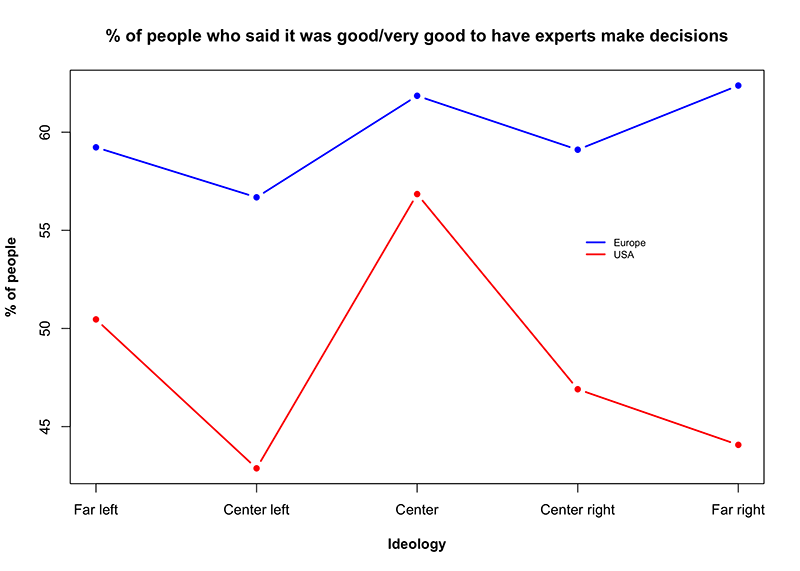
Now it’s centrists who are most supportive of technocracy in the US. In Europe, the far-Right is more supportive of technocracy but the differences between groups are much smaller. Personally, I’m not sure what to make of this, but I think it does at least show that the data are ambiguous.
Another problem is that the question of whether or not the data support Adler’s theory depends on how people are classified. As we have seen, based on the question in the EVS/WVS that asked people to place themselves on the Left-Right spectrum, Adler created five groups. But that isn’t the only possible—or even the most obvious—option. We might also classify those who answered 1 to 3 as “Left,” those who answered 4 to 7 as “center” and those who answered 8 to 10 as “Right.” Adler might object that his taxonomy is preferable because it’s more granular or because, under his system, each group is assigned the same number of positions on the Left-Right scale. But whether a given scientific taxonomy is good or bad does not hinge on those kind of a priori considerations. A valuable scientific taxonomy hinges on its explanatory power and it is not obvious that Adler’s classification has more explanatory power than the one I just proposed. Besides, if we’re trying to test the conventional wisdom that it is extremists who threaten democracy, it makes sense to single out those at either end of the Left-Right spectrum and lump everyone else together in the same group.
So what do we see when we look at the questions Adler examines using this alternative classification scheme? Once again, things become less clear, as you can see on this graph:
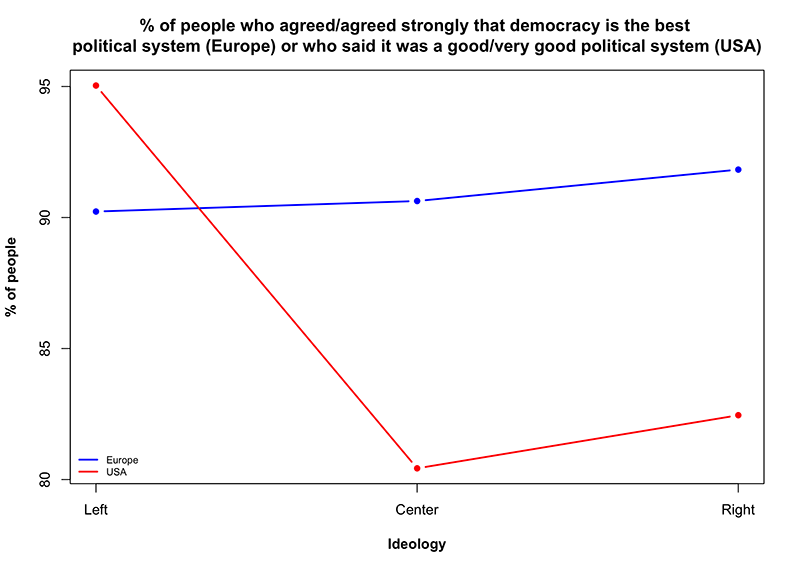
Now centrists no longer look so terrible. In Europe, every group is about as likely to agree that democracy is the best political system, while in the US, centrists are barely less likely to say it’s a good/very good political system than people on the Right. On the other hand, the situation doesn’t change much when you look at support for a strong leader, so I haven’t shown the graph for that.
The final issue with Adler’s theory is perhaps the most problematic. As we have seen, in order to classify people in five groups, he used a question in both the EVS and the WVS that asked people to place themselves on the Left-Right political spectrum. But in the case of the EVS, respondents are also asked for which party they would vote if elections were held today. In each country, parties have been placed on a similar 1 to 10 Left-Right scale by the people who administered the survey. So there is also a variable in the data that corresponds to the position on the Left-Right political spectrum of the party which respondents would vote for if elections were held at the time of the interview. What happens when you use that variable to classify people into Adler’s five groups? The effect disappears.
The following graph shows the proportion of people in each group (sorted by voting intention) who agree/agree strongly that democracy is the best political system:
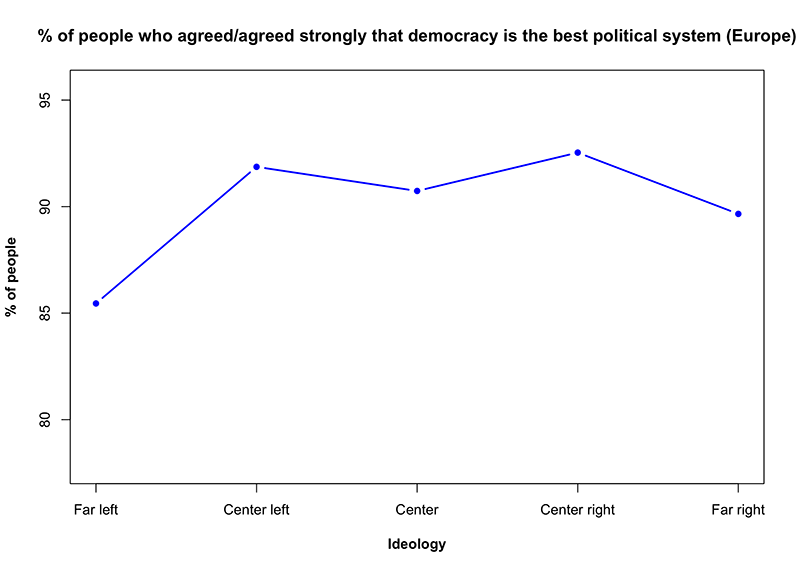
Now it’s the far-Left that seems to be the least supportive of democracy. Although, again, it’s worth bearing in mind that the proportion of people who say it’s a good system is very high in every group, so it’s not as if this graph showed a crisis of democracy in some groups.
The next graph shows the proportion of people in each group, classified by voting intention, who say that a strong leader is fairly good/very good:
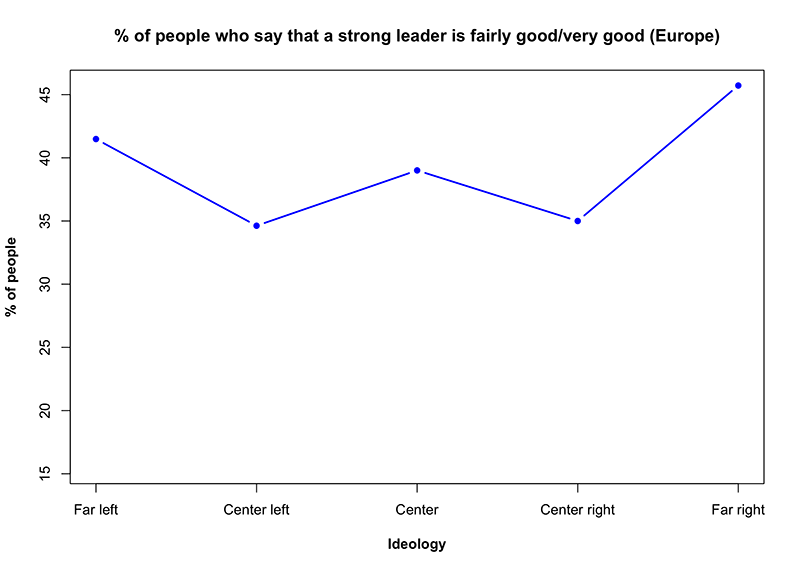
Again, we find that centrists don’t appear to be the most supportive of this kind of authoritarian alternative to democracy. As before, the far-Right is more supportive of it, but now so is the far-Left. In this case, support is pretty high across the political spectrum.
Why do we get different results when we classify respondents based on voting intention rather than political self-identification? It must be because the position respondents assign themselves on the Left-Right spectrum does not correspond to the position on that spectrum occupied by the parties for whom they intend to vote. Indeed, the correlation between the two variables is only 0.46. This is made pretty clear by the following graph, which shows where parties fall on the Left-Right spectrum relative to the people who say they would vote for them:
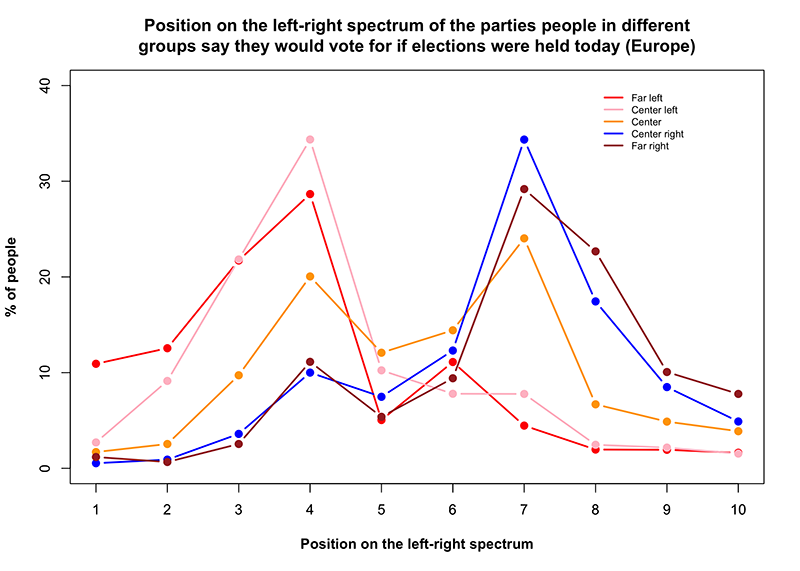
What these data reveal is a very imperfect match between respondents’ political self-identification on the Left-Right spectrum and the position occupied by the parties for whom they intend to vote.
This should not be especially surprising. People regularly engage in strategic voting and therefore don’t always vote for the party that is ideologically closest to their personal beliefs. In some countries and for some people, there may not even be a party that represents their views. But a correlation of 0.46 still strikes me as very low. Part of the story could also be that many people are simply clueless when it comes to accurately evaluating their own politics. Since few people like to think of themselves as extremists, it may be that quite a few people who place themselves in the middle of the political spectrum actually hold views that objectively put them at one extreme or the other. One could also argue that, in order to determine how attitudes toward democracy are distributed across the political spectrum, we should focus on the people who vote in accordance with their self-position on that spectrum, because they are the most committed representatives of each ideology.
As the latter part of this essay has explained, Adler’s conclusions seem to hinge in large part on how one measures and/or classifies people’s ideology. Although they are fairly diverse, the Left and Right still have relatively well defined intellectual traditions. It’s less clear what the equivalent is for the center. So it wouldn’t be surprising if the group of people who place themselves in the middle of the Left-Right political spectrum were more heterogenous and less coherent than the other groups in Adler’s taxonomy and didn’t really capture any well-defined political ideology/group. It may therefore just be harder to isolate those people we have in mind when we talk about “centrists” in this kind of survey data. This is a problem Adler could potentially address by looking at other attitudes people in that group express in the WVS/EVS and checking whether they cohere with what we’d expect of centrists. In turn, this will probably require a few more theoretical developments about centrism, so we know exactly who and what we’re talking about.
It’s very difficult to figure out what exactly is going on in the data and, unless Adler fixes these measurement/conceptual issues and looks at the data more systematically, I don’t think we should have much confidence in his conclusion that centrists are most hostile to democracy. As much as I would have liked to chide them for their lack of democratic commitment, I don’t think Adler’s paper has given me a good enough reason to do so. However, it is also worth noting that, even if I’m right to be skeptical of the claim that centrists are uniquely hostile to democracy, there is also not much in the data to support the view that extremists are uniquely hostile to democracy either. Given how widespread this view seems to be, especially among centrists, I think Adler will have made a valuable contribution even if that’s all he can show. Centrists may have no reason to be embarrassed, but they also have no reason to feel superior.
With the rise of various populist movements in Europe and the US in recent years, many people have expressed the fear that democracy might be in danger. My own view is that this fear is vastly exaggerated and reflects a fundamental misunderstanding of what is going on. Indeed, it seems to me that elites across the West have ignored the legitimate concerns of their citizens for a very long time, which is what gave rise to a populist revolt in many countries. But this revolt is likely more a symptom of the lack of democracy than a sign that people are fed up with it. I don’t think there is much chance it will lead to the kind of dystopias the sophisticates fear, although they may end up losing some of their influence. So I don’t find it particularly urgent to figure out who is about to deal democracy its death blow. But even if I’m wrong and democracy really is at risk, you probably shouldn’t be so quick to look to the political center to find the hand that will wield the knife.






